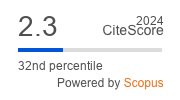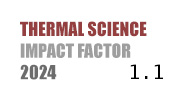THERMAL SCIENCE
International Scientific Journal
Thermal Science - Online First
online first only
Modeling interfacial properties of multicomponent fluids at high pressures using density gradient theory and Peng-Robinson equation of state
ABSTRACT
The interfacial properties of real systems consisting of complex mixtures are not easily accessible through experimentation. The Density Gradient Theory (DGT) coupled with the Peng-Robinson equation of state (PR-EOS) is applied here to predict the interfacial properties of the mixture, such as interfacial tension, interfacial thickness, and density profile within the interface, both far from and near the critical region. A modified algorithm has been developed to solve DGT equations without the need to select the reference fluid or estimate the domain size by explicitly introducing the time-dependent molar density term. The approach accurately describes the interfacial tensions of mixtures compared to the available experimental data. Furthermore, based on the obtained density profiles and interfacial thicknesses, the transition between the vapor-liquid two-phase and single-phase of the multicomponent system is quantified using the Knudsen number criterion under high-pressure conditions.
KEYWORDS
PAPER SUBMITTED: 2024-12-28
PAPER REVISED: 2025-03-29
PAPER ACCEPTED: 2025-03-31
PUBLISHED ONLINE: 2025-05-10
- Fang, T., et al., Oil detachment mechanism in CO2 flooding from silica surface: Molecular dynamics simulation, Chemical Engineering Science, 164. (2017), pp. 17-22, DOI No. 10.1016/j.ces.2017.01.067
- Liu, Z., et al., Pore scale and macroscopic visual displacement of oil-in-water emulsions for enhanced oil recovery, Chemical Engineering Science, 197. (2019), pp. 404-414, DOI No. 10.1016/j.ces.2019.01.001
- Mohammadmoradi, P., et al., Solvent diffusion and dispersion in partially saturated porous media: An experimental and numerical pore-level study, Chemical Engineering Science, 191. (2018), pp. 300-317, DOI No. 10.1016/j.ces.2018.06.072
- Fang, T., et al., Enhanced oil recovery with CO2/N-2 slug in low permeability reservoir: Molecular dynamics simulation, Chemical Engineering Science, 197. (2019), pp. 204-211, DOI No. 10.1016/j.ces.2018.12.016
- Xu, T.,Y.-C. Jin, Simulation the convective mixing of CO2 in geological formations with a meshless model, Chemical Engineering Science, 192. (2018), pp. 187-198, DOI No. 10.1016/j.ces.2018.07.016
- Rodriguez-Mosqueda, R., et al., CO2 capture from ambient air using hydrated Na2CO3 supported on activated carbon honeycombs with application to CO2 enrichment in greenhouses, Chemical Engineering Science, 189. (2018), pp. 114-122, DOI No. 10.1016/j.ces.2018.05.043
- Lu, J.,C.M. Corvalan, Influence of viscosity on the impingement of laminar liquid jets, Chemical Engineering Science, 119. (2014), pp. 182-186, DOI No. 10.1016/j.ces.2014.08.024
- Soni, A., et al., Formation of fluid structures due to jet-jet and jet-sheet interactions, Chemical Engineering Science, 191. (2018), pp. 67-77, DOI No. 10.1016/j.ces.2018.06.055
- Pei, B., et al., Flow and heat transfer of supercritical CO2 in the honeycomb ultra-compact plate heat exchanger, Journal of Supercritical Fluids, 148. (2019), pp. 1-8, DOI No. doi.org/10.1016/j.supflu.2019.02.023
- Chandra, B., et al., Study of gas/liquid behavior within an aeroengine bearing chamber, Journal of Engineering for Gas Turbines and Power-Transactions of the Asme, 135. (2013), 5, p. 051201
- Dahms, R.N.,J.C. Oefelein, On the transition between two-phase and single-phase interface dynamics in multicomponent fluids at supercritical pressures, Physics of Fluids, 25. (2013), 9, p. 092103, DOI No. 10.1063/1.4820346
- Wohlfarth, C., et al., Surface Tension of Pure Liquids and Binary Liquid Mixtures. Springer Berlin Heidelberg, 1997
- Lu, C., et al., A two-phase flash algorithm with the consideration of capillary pressure at specified mole numbers, volume and temperature, Fluid Phase Equilibria, 485. (2019), pp. 67-82, DOI No. 10.1016/j.fluid.2018.12.002
- Zuo, Y.X.,E.H. Stenby, Corresponding‐states and parachor models for the calculation of interfacial tensions, Canadian Journal of Chemical Engineering, 75. (1997), 6, pp. 1130-1137
- Winterfeld, P., et al., An approximate theory of interfacial tensions of multicomponent systems: Applications to binary liquid‐vapor tensions, AIChE Journal, 24. (1978), 6, pp. 1010-1014
- Toxvaerd, S.r., Perturbation theory for nonuniform fluids: surface tension, Journal of Chemical Physics, 55. (1971), 7, pp. 3116-3120
- Martínez-Ruiz, F.J., et al., Vapour-liquid interfacial properties of square-well chains from density functional theory and Monte Carlo simulation, Physical Chemistry Chemical Physics, 19. (2017), 19, pp. 12296-12309
- Becker, S., et al., Interfacial tension and adsorption in the binary system ethanol and carbon dioxide: Experiments, molecular simulation and density gradient theory, Fluid Phase Equilibria, 427. (2016), pp. 476-487, DOI No. 10.1016/j.fluid.2016.08.007
- Müller, E.A.,A. Mejía, Resolving Discrepancies in the Measurements of the Interfacial Tension for the CO2 + H2O Mixture by Computer Simulation, Journal of Physical Chemistry Letters, 5. (2014), 7, pp. 1267-1271, DOI No. 10.1021/jz500417w
- Miqueu, C., et al., Modeling of the Surface Tension of Multicomponent Mixtures with the Gradient Theory of Fluid Interfaces, Industrial & Engineering Chemistry Research, 44. (2005), 9, pp. 3321-3329, DOI No. 10.1021/ie049086l
- Mu, X., et al., Modified Density Gradient Theory for Surfactant Molecules Applied to Oil/Water Interfaces, Industrial & Engineering Chemistry Research, 57. (2018), 22, pp. 7643-7654, DOI No. 10.1021/acs.iecr.8b00164
- Kou, J.,S. Sun, A stable algorithm for calculating phase equilibria with capillarity at specified moles, volume and temperature using a dynamic model, Fluid Phase Equilibria, 456. (2018), pp. 7-24, DOI No. 10.1016/j.fluid.2017.09.018
- Stephan, S., et al., Vapor−Liquid Interface of the Lennard-Jones Truncated and Shifted Fluid: Comparison of Molecular Simulation, Density Gradient Theory, and Density Functional Theory, Journal of Physical Chemistry C, 122. (2018), 43, pp. 24705-24715, DOI No. 10.1021/acs.jpcc.8b06332
- Stimpson, B.C.,M.A. Barrufet, Thermodynamic Modeling of Pure Components Including the Effects of Capillarity, Journal of Chemical & Engineering Data, 61. (2016), 8, pp. 2844-2850, DOI No. 10.1021/acs.jced.6b00188
- Kahl, H.,S. Enders, Calculation of surface properties of pure fluids using density gradient theory and SAFT-EOS, Fluid Phase Equilibria, 172. (2000), 1, pp. 27-42
- Jaeger, P.T.,R. Eggers, Interfacial properties at elevated pressures in reservoir systems containing compressed or supercritical carbon dioxide, Journal of Supercritical Fluids, 66. (2012), pp. 80-85, DOI No. doi.org/10.1016/j.supflu.2011.12.024
- Mu, X., et al., Stabilized density gradient theory algorithm for modeling interfacial properties of pure and mixed systems, Fluid Phase Equilibria, 435. (2016),
- Schmidt, K.A.G., et al., Calculation of the interfacial tension of the methane-water system with the linear gradient theory, Fluid Phase Equilibria, 261. (2007), 1-2, pp. 230-237, DOI No. 10.1016/j.fluid.2007.07.045
- Miqueu, C., et al., Modelling of the surface tension of pure components with the gradient theory of fluid interfaces: a simple and accurate expression for the influence parameters, Fluid Phase Equilibria, 207. (2003), 1-2, pp. 225-246, DOI No. 10.1016/s0378-3812(03)00028-1
- Garrido, J.M., et al., Measurement and modeling of high pressure density and interfacial tension of carbon dioxide + tetrahydrofuran mixture, Journal of Supercritical Fluids, 128. (2017), pp. 359-369, DOI No. 10.1016/j.supflu.2017.04.008
- Larsen, P.M., et al., A collocation method for surface tension calculations with the density gradient theory, Fluid Phase Equilibria, 408. (2016), pp. 170-179, DOI No. doi.org/10.1016/j.fluid.2015.08.024
- Kou, J., et al., Efficient numerical methods for simulating surface tension of multi-component mixtures with the gradient theory of fluid interfaces, Computer Methods in Applied Mechanics and Engineering, 292. (2015), pp. 92-106, DOI No. 10.1016/j.cma.2014.10.023
- Liang, X., et al., Pitfalls of using the geometric-mean combining rule in the density gradient theory, Fluid Phase Equilibria, 415. (2016), pp. 75-83, DOI No. doi.org/10.1016/j.fluid.2016.01.047
- Miqueu, C., et al., Modelling of the surface tension of binary and ternary mixtures with the gradient theory of fluid interfaces, Fluid Phase Equilibria, 218. (2004), 2, pp. 189-203, DOI No. 10.1016/j.fluid.2003.12.008
- Qiao, Z.,S. Sun, Two-Phase Fluid Simulation Using a Diffuse Interface Model with Peng-Robinson Equation of State, SIAM Journal on Scientific Computing, 36. (2014), 4, pp. B708-B728, DOI No. 10.1137/130933745
- Weinaug, C.F.,D.L. Katz, Surface Tensions of Methane-Propane Mixtures, Industrial & Engineering Chemistry, 35. (1943), 2, pp. 239-246, DOI No. 10.1021/ie50398a028
- Lemmon, E.W., et al., NIST standard reference database 23: reference fluid thermodynamic and transport properties-REFPROP, version 8.0, 'Report, 2007
- Mejía, A., et al., Simultaneous prediction of interfacial tension and phase equilibria in binary mixtures, Fluid Phase Equilibria, 227. (2005), 2, pp. 225-238, DOI No. 10.1016/j.fluid.2004.10.024
- Liang, X., et al., A density gradient theory based method for surface tension calculations, Fluid Phase Equilibria, 428. (2016), pp. 153-163, DOI No. 10.1016/j.fluid.2016.06.017
- Nagarajan, N., et al., Equilibrium phase compositions, phase densities, and interfacial tensions for carbon dioxide+ hydrocarbon systems. 6. Carbon dioxide+ n-butane+ n-decane, Journal of Chemical and Engineering Data, 35. (1990), 3, pp. 228-231
- Faeth, G.M., et al., Supercritical bipropellant droplet combustion, Symposium (International) on Combustion, 12. (1969), 1, pp. 9-18, DOI No. doi.org/10.1016/S0082-0784(69)80387-5
- Liu, S., et al., Investigation of Bulk and Interfacial Properties for Nitrogen and Light Hydrocarbon Binary Mixtures by Perturbed-Chain Statistical Associating Fluid Theory Combined with Density-Gradient Theory, Industrial & Engineering Chemistry Research, 48. (2009), 23, pp. 10734-10739, DOI No. 10.1021/ie9007437
- Nino-Amezquita, O.G., et al., Measurement and Prediction of Interfacial Tension of Binary Mixtures, Industrial & Engineering Chemistry Research, 49. (2010), 2, pp. 592-601, DOI No. 10.1021/ie901209z
- Dechoz, J.,C. Rozé, Surface tension measurement of fuels and alkanes at high pressure under different atmospheres, Applied Surface Science, 229. (2004), 1, pp. 175-182, DOI No. doi.org/10.1016/j.apsusc.2004.01.057
- Lekner, J.,J.R. Henderson, Theoretical determination of the thickness of a liquid-vapour interface, Physica A: Statistical Mechanics and its Applications, 94. (1978), 3-4, pp. 545-558
- Dahms, R.N., et al., Understanding high-pressure gas-liquid interface phenomena in Diesel engines, Proceedings of the Combustion Institute, 34. (2013), 1, pp. 1667-1675, DOI No. 10.1016/j.proci.2012.06.169

